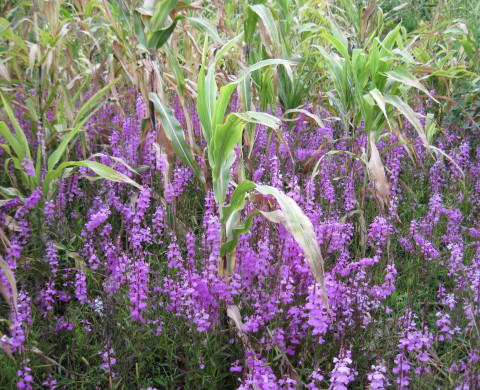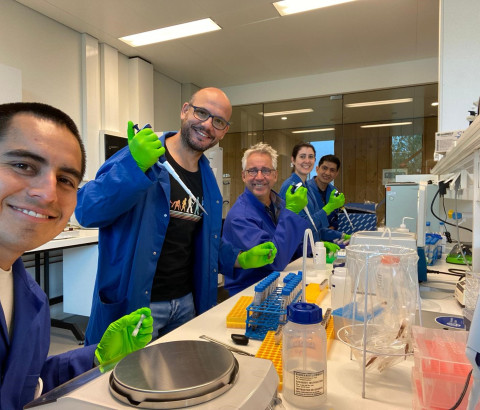Microbes for plant health

Plants live closely together with soil microbes. They rely on each other for growth and health. NIOO scientists study these interactions, aiming to make food production more sustainable.
All terrestrial and aquatic plants live in close association with a wealth of microbes belowground. These soil microbes feed on root exudates: substances that plants excrete. In return, the microbes stimulate plant growth and health. NIOO scientists study these interactions – and also how to steer the microbial community composition and activities. This research can support sustainable food production and mitigate greenhouse gas emissions.
Hundreds of millions of bacteria, viruses and fungi live in a teaspoon of fertile soil. These microbes form an intricate community that interacts closely with plant roots. People tend to associate microbes with disease, but in fact many of the interactions between microbes and plants are beneficial. The microbes make nutrients available to the plants and play a role in plants’ defence against drought, pests and diseases. In turn, the plants provide the microbes with sugars and other organic compounds.
Many of these interactions are surprisingly complex, involving cascades of actions and reactions. These cascades determine how plants thrive and compete, how they recruit microbial support when attacked, and even which greenhouse gases are released from the soil.
“At NIOO, we investigate the ecology, genetics and chemistry of these interactions”, says Jos Raaijmakers, head of the NIOO Microbial Ecology department and professor of Microbial Ecology at Leiden University. “If we know more about what goes on in the soil surrounding plant roots, we might be able to tweak those microbiomes to our advantage. We might use their potential to promote plant health and productivity, and even to reduce greenhouse gas emissions.”
Many people don’t know that plant roots are covered in microbes, and that the surrounding soil is teeming with microbial life as well – much like our own human gut microbiota. And, just like in the human body, these microbiomes fulfil a wide range of ecological functions. “We still know little about these functions”, says Raaijmakers. “At NIOO, we are trying to learn from nature and use the obtained knowledge for the sustainable production of food and feed.”
Wietse de Boer, senior scientist at NIOO and special professor of Microbial Soil Ecology at Wageningen University: “If you provide the microbes with the right food and the right conditions, they promote plant performance. You can reduce the use of fertilizer and pesticides if you steer the microbes in the right way. But to do that, we need to really understand those plant-microbe and microbe-microbe interactions. We need to know how these complex networks affect the system as a whole.”
Bringing back the ‘missing plant microbes’
One NIOO project is called ‘Back2Roots’. It focuses on the impact of plant domestication on the associated microbiomes and their interactions. “Just like plant traits are lost during domestication, so are certain microbes”, says Raaijmakers. “In some cases, we’d like to identify the ‘missing beneficial microbes’ and bring them back in modern agriculture to fulfil important functions for the crop plants.”
To do so, the scientists first need to map which traits and genes in the wild relatives of our crop species, like tomato and potato, are associated with which microbes and which beneficial functions. The next step is to figure out how to stimulate those functions in agricultural soils. This can be done by introducing microbial communities onto plant seeds, by stimulating indigenous microbes with certain nutrients or compounds – or by bringing genes back into the crops that allow exudation of specific organic compounds from the root that recruit or activate the beneficial microbes.
‘Farming’ microbes
Eiko Kuramae is a senior scientist at NIOO and professor of Microbial Community Ecology & Environmental Genomics at Utrecht University. Her specialty is the relationship between plants, soil microbiomes in nutrient cycling and nitrous oxide emissions. ”We ‘farm’ microbes to provide nutrients to plants, soil quality and N2O mitigation”, she says.
Microbial Farming is a concept that Kuramae developed and that aims to increase the co-dependency between soil microbes and crop plants. “Ultimately, this increased co-dependency can increase the plant nutrient use efficiency”, she explains, “and thus, Microbial Farming is the set of agricultural practices that steer the soil microbes to promote plant growth and deliver ecological services, such as nitrogen fixation, phosphate solubilization, mitigation of N2O.
In the project ‘Microbial Farming to increase plant productivity’, Kuramae and colleagues work together with seed and starting materials companies, including for chrysanthemum and cucumber crops. Together, they are increasing the co-dependency between plantlets and soil beneficial microbes by manipulating soil nutrients in order to have healthy and high-quality plants. “We also steer soil native beneficial microbes for mitigation of N2O and plant growth”, says Kuramae, “using biopolymers derived from organic residues as bio-stimulants”.
This can also be part of a future circular economy, adds department head Raaijmakers: “Using waste streams to stimulate beneficial microbes.”
Crop protection
Wietse de Boer studies the use of microbiomes for crop protection. His focus lies on competition between fungi and bacteria. “When fungi become more abundant in the soil, the bacteria have to weapon themselves”, he says. “Within the bacterial community, there is a shift towards bacteria with antifungal properties. We can use this concept to protect crops from pathogens.”
This can be done, as he explains, by feeding the fungi with solid organic matter, such as sawdust from deciduous trees: a quick, long-lasting stimulant. In turn, the bacterial community in the soil will produce more antifungal compounds, which benefits the farmer’s crops. “This is working pretty well in agriculture”, says De Boer. “Also, the soil food web will become more complex. With more fungi present, organisms that feed on fungi will also become more abundant, such as nematodes, which in turn feed a whole range of organisms.” In general, increased biodiversity means better resilience against drought, pests and disease.
In collaboration with practice
These are just some examples of projects, as all three scientists underline. “We are working on a range of projects, larger and smaller”, says Raaijmakers. “They usually involve collaborations with other research partners and with companies.” Some projects are fundamental in nature: they focus on understanding concepts and mechanisms. Others have a more practical orientation. “This is really stimulating”, says Raaijmakers. “It ensures that we are working on questions that are highly relevant for practice – and it allows us to test our microbial solutions in field trials. A very fruitful cooperation.”
Experts
-
Jos Raaijmakers
Head of department , Microbial Ecology
-
Eiko Kuramae
Senior Researcher , Microbial Ecology
-
Wietse de Boer
Researcher , Microbial Ecology
Applications
- More sustainable food production
- Environmental policies




